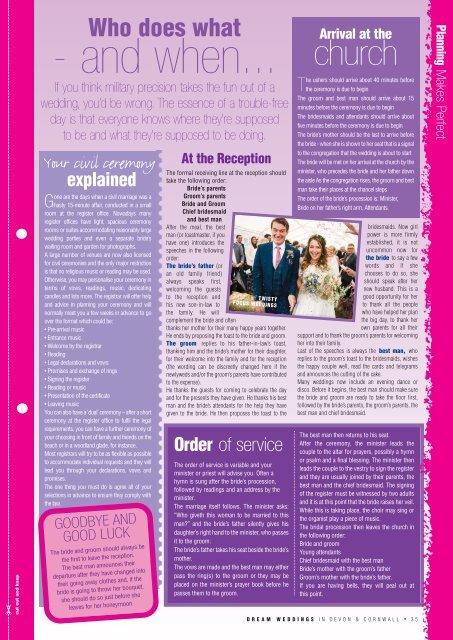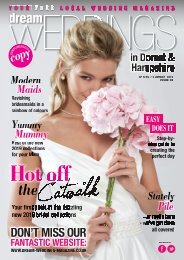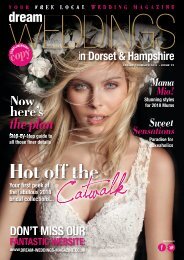Dream Weddings Magazine - Devon & Cornwall - issue.32
Planning your wedding starts here and now and in Dream Weddings you will find tips and hints on every aspect of your big day, from the latest collections of gowns to transport, from wedding day etiquette to up-to-date fashions in flowers. You’ll also find advertisements from a whole army of local businesses, all with plenty of experience to call on. They will work with your ideas, offer creative suggestions of their own and find solutions to match every budget. They know the shortcuts and the pitfalls - and they’re fully aware of how important it is to you that everything runs smoothly. So start planning your big day. And enjoy every minute of it!
Planning your wedding starts here and now and in Dream Weddings you will find tips and hints on every aspect of your big day, from the latest collections of gowns to transport, from wedding day etiquette to up-to-date fashions in flowers. You’ll also find advertisements from a whole army of local businesses, all with plenty of experience to call on. They will work with your ideas, offer creative suggestions of their own and find solutions to match every budget. They know the shortcuts and the pitfalls - and they’re fully aware of how important it is to you that everything runs smoothly. So start planning your big day. And enjoy every minute of it!
Create successful ePaper yourself
Turn your PDF publications into a flip-book with our unique Google optimized e-Paper software.
cut out and keep<br />
Who does what<br />
- and when...<br />
If you think military precision takes the fun out of a<br />
wedding, you’d be wrong. The essence of a trouble-free<br />
day is that everyone knows where they’re supposed<br />
to be and what they’re supposed to be doing.<br />
Your civil ceremony<br />
explained<br />
Gone are the days when a civil marriage was a<br />
hasty 15-minute affair, conducted in a small<br />
room at the register office. Nowadays many<br />
register offices have light, spacious ceremony<br />
rooms or suites accommodating reasonably large<br />
wedding parties and even a separate bride’s<br />
waiting room and garden for photographs.<br />
A large number of venues are now also licensed<br />
for civil ceremonies and the only major restriction<br />
is that no religious music or reading may be used.<br />
Otherwise, you may personalise your ceremony in<br />
terms of vows, readings, music, dedicating<br />
candles and lots more. The registrar will offer help<br />
and advice in planning your ceremony and will<br />
normally meet you a few weeks in advance to go<br />
over the format which could be:<br />
• Pre-arrival music<br />
• Entrance music<br />
• Welcome by the registrar<br />
• Reading<br />
• Legal declarations and vows<br />
• Promises and exchange of rings<br />
• Signing the register<br />
• Reading or music<br />
• Presentation of the certificate<br />
• Leaving music<br />
You can also have a ‘dual’ ceremony – after a short<br />
ceremony at the register office to fulfil the legal<br />
requirements, you can have a further ceremony of<br />
your choosing in front of family and friends on the<br />
beach or in a woodland glade, for instance.<br />
Most registrars will try to be as flexible as possible<br />
to accommodate individual requests and they will<br />
lead you through your declarations, vows and<br />
promises.<br />
The one thing you must do is agree all of your<br />
selections in advance to ensure they comply with<br />
the law.<br />
GOODBYE AND<br />
GOOD LUCK<br />
The bride and groom should always be<br />
the first to leave the reception.<br />
The best man announces their<br />
departure after they have changed into<br />
their going away clothes and, if the<br />
bride is going to throw her bouquet,<br />
she should do so just before she<br />
leaves for her honeymoon.<br />
At the Reception<br />
The formal receiving line at the reception should<br />
take the following order:<br />
Bride’s parents<br />
Groom’s parents<br />
Bride and Groom<br />
Chief bridesmaid<br />
and best man<br />
After the meal, the best<br />
man (or toastmaster, if you<br />
have one) introduces the<br />
speeches in the following<br />
order:<br />
The bride’s father (or<br />
an old family friend)<br />
always speaks first,<br />
welcoming the guests<br />
to the reception and<br />
his new son-in-law to<br />
the family. He will<br />
complement the bride and often<br />
thanks her mother for their many happy years together.<br />
PHOTO BY TWISTY<br />
FOCUS WEDDINGS<br />
He ends by proposing the toast to the bride and groom.<br />
The groom replies to his father-in-law’s toast,<br />
thanking him and the bride’s mother for their daughter,<br />
for their welcome into the family and for the reception<br />
(the wording can be discreetly changed here if the<br />
newlyweds and/or the groom’s parents have contributed<br />
to the expense).<br />
He thanks the guests for coming to celebrate the day<br />
and for the presents they have given. He thanks his best<br />
man and the bride’s attendants for the help they have<br />
given to the bride. He then proposes the toast to the<br />
Order of service<br />
The order of service is variable and your<br />
minister or priest will advise you. Often a<br />
hymn is sung after the bride’s procession,<br />
followed by readings and an address by the<br />
minister.<br />
The marriage itself follows. The minister asks:<br />
“Who giveth this woman to be married to this<br />
man?” and the bride’s father silently gives his<br />
daughter’s right hand to the minister, who passes<br />
it to the groom.<br />
The bride’s father takes his seat beside the bride’s<br />
mother.<br />
The vows are made and the best man may either<br />
pass the ring(s) to the groom or they may be<br />
placed on the minister’s prayer book before he<br />
passes them to the groom.<br />
Arrival at the<br />
church<br />
The ushers should arrive about 40 minutes before<br />
the ceremony is due to begin<br />
The groom and best man should arrive about 15<br />
minutes before the ceremony is due to begin<br />
The bridesmaids and attendants should arrive about<br />
five minutes before the ceremony is due to begin<br />
The bride’s mother should be the last to arrive before<br />
the bride - when she is shown to her seat that is a signal<br />
to the congregation that the wedding is about to start<br />
The bride will be met on her arrival at the church by the<br />
minister, who precedes the bride and her father down<br />
the aisle As the congregation rises, the groom and best<br />
man take their places at the chancel steps<br />
The order of the bride’s procession is: Minister,<br />
Bride on her father’s right arm, Attendants.<br />
bridesmaids. Now girl<br />
power is more firmly<br />
established, it is not<br />
uncommon now for<br />
the bride to say a few<br />
words and if she<br />
chooses to do so, she<br />
should speak after her<br />
new husband. This is a<br />
good opportunity for her<br />
to thank all the people<br />
who have helped her plan<br />
the big day, to thank her<br />
own parents for all their<br />
support and to thank the groom’s parents for welcoming<br />
her into their family.<br />
Last of the speeches is always the best man, who<br />
replies to the groom’s toast to the bridesmaids, wishes<br />
the happy couple well, read the cards and telegrams<br />
and announces the cutting of the cake.<br />
Many weddings now include an evening dance or<br />
disco. Before it begins, the best man should make sure<br />
the bride and groom are ready to take the floor first,<br />
followed by the bride’s parents, the groom’s parents, the<br />
best man and chief bridesmaid.<br />
The best man then returns to his seat.<br />
After the ceremony, the minister leads the<br />
couple to the altar for prayers, possibly a hymn<br />
or psalm and a final blessing. The minister then<br />
leads the couple to the vestry to sign the register<br />
and they are usually joined by their parents, the<br />
best man and the chief bridesmaid. The signing<br />
of the register must be witnessed by two adults<br />
and it is at this point that the bride raises her veil.<br />
While this is taking place, the choir may sing or<br />
the organist play a piece of music.<br />
The bridal procession then leaves the church in<br />
the following order:<br />
Bride and groom<br />
Young attendants<br />
Chief bridesmaid with the best man<br />
Bride’s mother with the groom’s father<br />
Groom’s mother with the bride’s father.<br />
If you are having bells, they will peal out at<br />
this point.<br />
D R E A M W E D D I N G S I N D E V O N & C O R N W A L L • 3 5<br />
Planning Makes Perfect
















